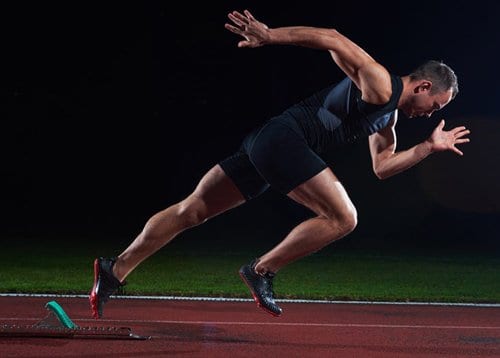Whether you are a top athlete or training to keep yourself fit, you need recovery. The effect of your training is not worth much if not prioritizing recovery, yet many downplay the recovery in their training, often primarily due to lack of time. In these circumstances Recovery Boots might be a solution. Recovery Boots can effectively increase the blood flow in your muscles and help get rid of the waste products, which in turn will help you recover faster.
Recovery boots are using air compression to force the venous fluid back. That way, your body gets rid of waste products and the blood flow will increase.
The science behind Recovery Boots?
A number of studies have been done on the effects of Recovery Boots. The boots can i.a. assist in:
- Faster recovery.
- Prevent injuries or make injury periods smaller.
- Better results through less muscle soreness and increased flexibility.
Faster Recovery
When you exercise, you ‘stress’ your muscles, causing minor tears to your muscle fibres. These tears are what will later cause you to improve, but initially they result in muscle inflammation and the accumulation of metabolic waste (lactate, pyruvate, ammonia, bicarbonate and pH).
The small muscle injuries result in a combination of soreness, fatigue and reduced muscle strength, which limit your ability to train at full strength and get the most benefit from your workout. That’s why the ability to recover rapidly is so important.
By using recovery boots in your daily workout, you can speed up the recovery process that your body’s lymphatic and vascular systems perform naturally over a longer period of time. Pneumatic compression increases blood circulation and helps your body get rid of accumulated waste in your muscles faster and more efficiently than your body normally can. The result is that your muscles heal and recover faster.

“…the MISPD effected a 45% improvement in the subjects’ ability to perform the subsequent exercise bout. The accumulation of fluid in the interstitial space after exercise and its disappearance after the use of the MISPD offers one possible explanation for these results….” Read more
“The purpose was to determine if intermittent pneumatic compression (IPC) affects muscle swelling, stiffness, and strength loss… We hypothesized that the compression would decrease swelling and stiffness. …Results: Circumference and stiffness increased and strength decreased during the 5 days post-exercise …. ….Conclusion: IPC is effective in temporarily decreasing the swelling and stiffness after exercise-induced muscle injury.” Read more
Prevent injury or recover from them faster
Injuries are very disruptive to your training and are the athlete’s worst nightmare. Injuries such as shin splints, inflammation of the Achilles tendon and runners knee are nevertheless something that most athletes have experienced.
There may be many reasons for your injury; technique, excessive training and lack of recovery. You should therefore refrain from doing too much, too often and too quickly. The body needs time to adapt to changes in your workout, and to changes in your training hours or intensity. Muscles and joints require recovery time so that they can recover and cope with the requirements imposed by your training. If you force the exercise process, you may break down your body instead of building it up.
Research shows that compression and massage improve oxygenation and reduce inflammation and muscle micro-trauma (the small tears that training causes in your muscles). In this way, a set of recovery boots can help you recover from your training faster and thus reduce your risk of injury caused by excessive training.

“The main mechanism for the effectiveness ofIntermittent pneumatic compression (IPC) is that it augments venous and arterial blood flow via the periodic inflation of external cuffs. We believe that this may be beneficial to the warmdown activities of athletes. The removal of waste products may help to reduce injury risk and the phenomenon of delayed onset muscle soreness (DOMS)”. Read more
“Compression is a therapeutic technique widely used in the treatment of muscle and other soft tissue injuries, though evidence in support of this remedial therapy has until recently being largely anecdotal. Recent scientific research has indicated that external compression can be an effective treatment that minimises swelling, improves the alignment and mobility of scar tissue, and improves proprioception in an injured joint consequent to eccentric damage models and DOMS.” Read more
Better Results
Although there are many factors to consider when you want to improve your performance, the ability to consistently perform your training is a high priority, in addition to the quality of your workout.
However, consistent training is not enough if your body has not sufficiently recovered. Muscle soreness, reduced muscle strength and fatigue will dramatically reduce the effectiveness of your workout and may lead to a downward spiral that prevents you from exercising regularly and may also be a potential risk of injury (excessive training).
To prevent the above, the vast majority of top athletes include regular recovery periods in their training schedules. Sufficient sleep and proper nutrition can help ensure a good recovery. If you include at least a 30-minute compression session in recovery boots, you will experience additional recovery benefits.
The compression in a set of recovery boots will increase blood circulation and speed up your body’s natural recovery process by eliminating the accumulation of metabolic waste products and lactate after training. Users of Optima Sport recovery boots often experience that their muscles are:
- Less sore.
- Fresher.
- Looser.
- Less fatigued.
These benefits can help you get the most from your training. The ability to recover faster after your last training session can help you to maintain (or even increase) your exercise volume and intensity, which can ultimately improve your performance.

“This study investigated the effects of peristaltic pulse dynamic compression (PPDC) on range-of-motion (ROM) changes in forward splits. Serious stretching usually involves discomfort and large time investments. Tissue structural changes and stretch tolerance have heretofore been considered the primary mechanisms of enhanced ROM.”. Read more
“Difference score results showed that the experimental group's PPT threshold improved after PPDC treatment immediately and persisted the remainder of the day after afternoon practice. The control group showed no statistical change. We conclude that PPDC is a promising means of accelerating and enhancing recovery after the normal aggressive training that occurs in Olympic and aspiring Olympic athletes.” Read more



